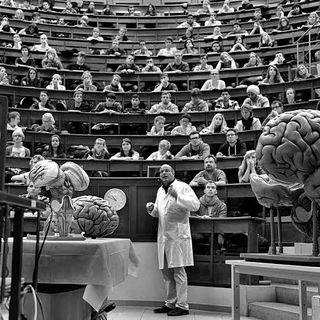
Extreme Period Pain, or Acute Dysmenorrhea, Is a Real Health Issue
“I sit frozen for hours on the toilet seat and just cramp, bleed out huge clots and suffer from severe diarrhea on the first day of my period.”

Every month, for two days, I’m barely conscious.
When I get my period, every inch of my upper body hurts as if someone has bruised me with a bat. Every inch of my lower body is numb. I bleed excessively, having to wear two pads simultaneously at all points. I can’t sit, stand up straight, lie down, walk, eat or sometimes even turn in bed. Past injuries begin to hurt again. Besides these symptoms, which last up to 48 hours, cramps come in waves so strong that I see blinding white light. I often get ‘locked’ — stuck in a position, unable to get out of it without screaming out in agony or making an SOS call to a neighbor. I end up in the Emergency Room more often than not for narcotic injections to soothe the pain.
Painful periods, common to most women in varying degrees, are known as dysmenorrhea, and they range from mild discomfort and nausea to painful cramps manageable with over-the-counter medication.
“When a patient comes and tells us that they’re having painful periods, we say they have dysmenorrhea. Since pain is subjective … everyone’s level of pain tolerance is different … when they come to us, we believe them and term it that,” says Dr. Devika Chopra, a gynecologist and obstetrician at Hope Clinic in Tardeo, Mumbai.
However, some women face the more acute end of this pain spectrum — doctors have compared it to a heart attack, even — when they menstruate. These cramps interfere with women’s daily lives and productivity levels and are often accompanied by heavy bleeding and spasms of pain that wrack the whole body.
“The thing to remember is that period pain is very real and can be debilitating.”
“Once the patient with dysmenorrhea comes to us, we begin the clinical process of exclusion to determine the cause of the pain. For instance, if they have any uterine cysts or polyps or endometriosis, which is a little harder to diagnose. In this case, the dysmenorrhea is secondary to a cause, so it’s termed ‘secondary dysmenorrhea.’ When there is no cause … when it’s just the anatomy of the patient, their basic structure is the reason, we call it ‘primary dysmenorrhea,'” explains Dr. Chopra.
The clinical process of exclusion to determine the cause of dysmenorrhea includes a review of the patient’s medical history, including their symptoms and menstrual cycles, and a pelvic exam. Doctors may also do an ultrasound or in some cases, a laparoscopy, a type of surgery that lets them look inside the pelvic region.
What is primary dysmenorrhea?
Dysmenhorrea caused due to an inherent structural issue with a woman’s anatomy is known as primary dysmenhorrea. According to Medscape, “[it] is defined as menstrual pain that is not associated with macroscopic pelvic pathology (i.e., occurs in the absence of pelvic disease). It typically occurs in the first few years after menarche and affects as many as 50% of postpubertal females.”
It can occur in women for a number of reasons: “Imagine a pipe with a small opening and you’re trying to push water through the pipe. It’ll require more pressure. Similarly, to push the menstrual blood out of a small cervix — we call it a pinpoint cervix — the body will exert more pressure, causing more pain,” says Dr. Chopra, also throwing light on why I suffer my ghastly fate every month.
“Then, some women have relatively more dilated veins, which means more blood supply to the area.” Other reasons range from women having a retroverted or tilted uterus (that bends towards the rectum instead of towards the belly), or an increased synthesis of prostaglandins (a compound made at the site of tissue damage that catalyzes blood clotting and cause inflammation, swelling, pain and fever as a part of the body’s natural healing process).
“I sit frozen for hours on the toilet seat and just cramp, bleed out profusely and suffer from severe diarrhea on the first day of my period,” says Ragini Sachdeva, 31. When she went to a doctor initially, the extent of her pain was dismissed; she was asked to use a hot water bottle and rest. It was only when she had to go to the hospital in pain that she was prescribed appropriate medication.
Related on The Swaddle:
Some Doctors See Pain As Just A Symptom of Being Female
Usually, primary dysmenorrhea begins soon after a girl starts menstruating and may reduce as she gets older. This kind of dysmenorrhea also may improve after giving birth, due to the dilation of the cervix.
Pain in this case usually occurs right before the period begins, as the level of prostaglandins increases in the uterine lining, peaking on day one and reducing as the period continues and the lining is shed.
What is secondary dysmenorrhea?
When the cause of dysmenorrhea is a separate, underlying health condition, such as pelvic infections, endometriosis (in which tissue from the uterine lining grows outside the uterus), fibroids, ovarian cysts or in some cases, a dislodged intrauterine contraceptive device, doctors term it as secondary dysmenorrhea.
“I used to throw up and excrete anything I ingested, even water, for the first two days of my period. Nausea and spasms were the only two things I could feel in my body. I couldn’t stand up with my back straight and the undersides of my feet would have a constant dull ache. I felt paralyzed until I went to my doctor. We found out I had two large ovarian cysts,” explains Komal Goyal, 31. After undergoing surgery for their removal, Goyal says, it’s as if she has “a new lease on life.”
This disorder usually begins later in life than primary dysmenorrhea; it is most often observed in women aged 30 to 45 years. This pain lasts longer than normal menstrual cramps and may begin a few days before a period begins. The pain may get worse as the period continues and even after it ends.
Related on The Swaddle:
Women With Endometriosis Turning to Alternative Therapies for Relief
How do you deal with extremely painful periods?
If it is a case primary dysmenorrhea, doctors may prescribe antispasmodics such as Drotin, or Meftal, which is part anti-spasmodic and part-paracetamol (kills the prostaglandins). Other non-steroidal anti-inflammatory drugs such as ibuprofen and naproxen are also capable of relieving primary dysmenorrhoea. Hormonal medication such as “oral contraceptive pills can really help regulate the hormones in your body as well as reduce bleeding,” says Dr. Chopra, adding that the newer low-dosage pills have nearly no side effects these days.
Relaxing with a hot shower or a hot water bottle, taking back and stomach massages, and wearing loose clothes can help reduce the pain. Some studies also suggest aromatherapy and acupuncture are useful ways to ease menstrual spasms. Lifestyle changes such as reducing smoking, drinking, and the consumption of red meat, salt, and sugar, can also ease symptoms of primary and secondary dysmenorrhea.
“Mild exercise before and during periods can also help ease the pain. In fact, it should be made a part of your daily routine to help regulate the blood supply in your body. Eating well, sleeping well, not stressing too much … ensuring your general well-being is very important for reducing period pains, in general,” says Dr. Chopra.
Related on The Swaddle:
Chronic Pelvic Pain is More Than Just Period Cramps
To mitigate or resolve secondary dysmenhorrea, that is, painful periods as a result of some underlying pelvic disorder, the underlying medical condition needs to be appropriately treated first.
According to the American College of Obstetricians and Gynecologists, if your symptoms or a laparoscopy point to endometriosis as the cause of your dysmenorrhea, in addition to specific medication for the disorder, “birth control pills, the birth control implant, the injection, or the hormonal intrauterine device can be tried.” If fibroids are the reason for your pain, doctors may prescribe a treatment called uterine artery embolization to stop unwanted growths.
Usually, it is a mix of treatments that works best.
However, if these treatments don’t work, doctors may suggest undergoing surgery to remove the fibroids or the endometriosis tissue causing the pain. A hysterectomy, in which the entire uterus is removed, can be a last resort treatment for painful cramps for women who don’t want children.
When should you see a doctor for period pains?
“If you are losing a lot of blood, can’t get out of bed, feeling faint or a general state of unwellness, go visit your doctor. People’s pain tolerance is different — some people can tolerate a lot of pain, some need a to have a medicine for headaches — so when you feel that your quality of life is getting affected by pain, when you cannot comfortably follow your daily routine, go visit your doctor,” says Dr. Chopra, “because the thing to remember is that period pain is very real and can be debilitating.”
Pallavi Prasad is The Swaddle's Features Editor. When she isn't fighting for gender justice and being righteous, you can find her dabbling in street and sports photography, reading philosophy, drowning in green tea, and procrastinating on doing the dishes.
Related


Debunking the Stigma Behind Borderline Personality Disorder
